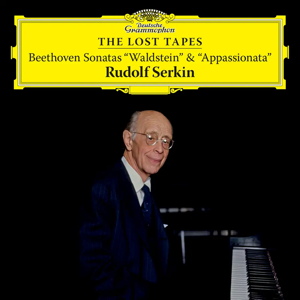
Ludwig van Beethoven (1770-1827)
The Lost Tapes
Piano Sonata No. 21 in C major, Op. 53 ‘Waldstein’
Piano Sonata No. 23 in F minor, Op 57 ‘Appassionata’
Rudolf Serkin (piano)
rec. 1986, SUNY Purchase College, New York, USA (Op.53); 1989, Guildford Sound, Vermont, USA (Op. 57)
Deutsche Grammophon 4864935 [55]
This release marks both the 125th anniversary of Deutsche Grammophon and the 120th anniversary of the birth of the Austrian-American pianist Rudolf Serkin. In the accompanying booklet’s preface, Judith Serkin, the pianist’s daughter, discusses her father’s approach to the recording process. It appears he wasn’t entirely comfortable with it, and was never fully satisfied with his recordings; he was always reluctant to approve them. The Waldstein and Appassionata we have here were taped late on in the pianist’s life, in 1986 and 1989 respectively, and due to illness were never sanctioned by Serkin. They were his final studio inscriptions. He died in 1991 before he could give them his approval. Now, fortunately for those of us to cherish the legacy of Rudolf Serkin, the project carries the imprimatur of his daughter.
Serkin was a renowned Beethoven interpreter, and both of these works feature in his earlier discography when he was a much younger man and in better technical shape. Nevertheless, there’s much to applaud here. Of the two sonatas I think that the Waldstein fares the best. The recording was made at SUNY Purchase College Recital Hall, New York, in March 1986. I’m amazed by the beauty of tone he elicits from the piano, more so as this has not always been the case. I agree with one Sunday Times critic who once described his playing as “overemphatic and disconcertingly percussive”. There’s no hint of that here. His playing has mellowed and rid itself of a certain impetuousness. The Waldstein has great breadth and vision. This is very evident in the sublime yet brief Adagio molto central movement, which is beautiful and poetically contoured. The final movement is noteworthy for the crystalline clarity of Serkin’s articulation.
Three years later in 1989 at Guildford Sound, Vermont he set down the Appassionata. Tempos in the outer movements are slower than the recording he made in the 1960s, and technically there are some shortcomings in the faster passages. In the finale, especially, I felt some elements of strain creep in. It’s the middle movement which is the most successful. The theme is prayer-like, and the variations unfold in steady tempo with ethereal calm.
Sound quality is consistent over both venues, and the piano emerges with a rich rounded tone and bloom. The excellent booklet note by Jed Distler is the icing on the cake. Though these are in no way benchmark recordings, they do offer the listener a glimpse into Serkin’s final thoughts in works that have been central to his repertoire over a lifetime.
Stephen Greenbank
Help us financially by purchasing from



















